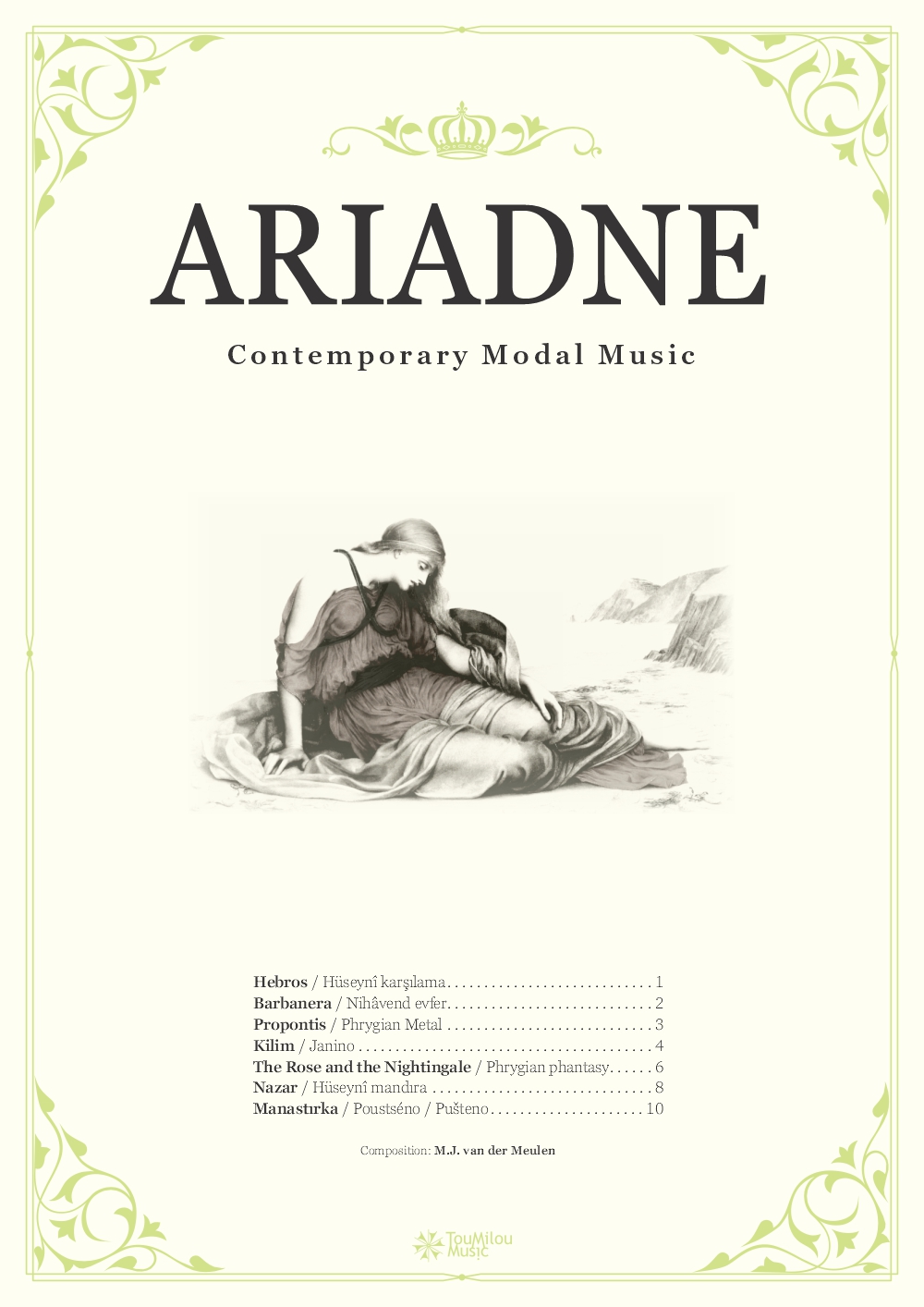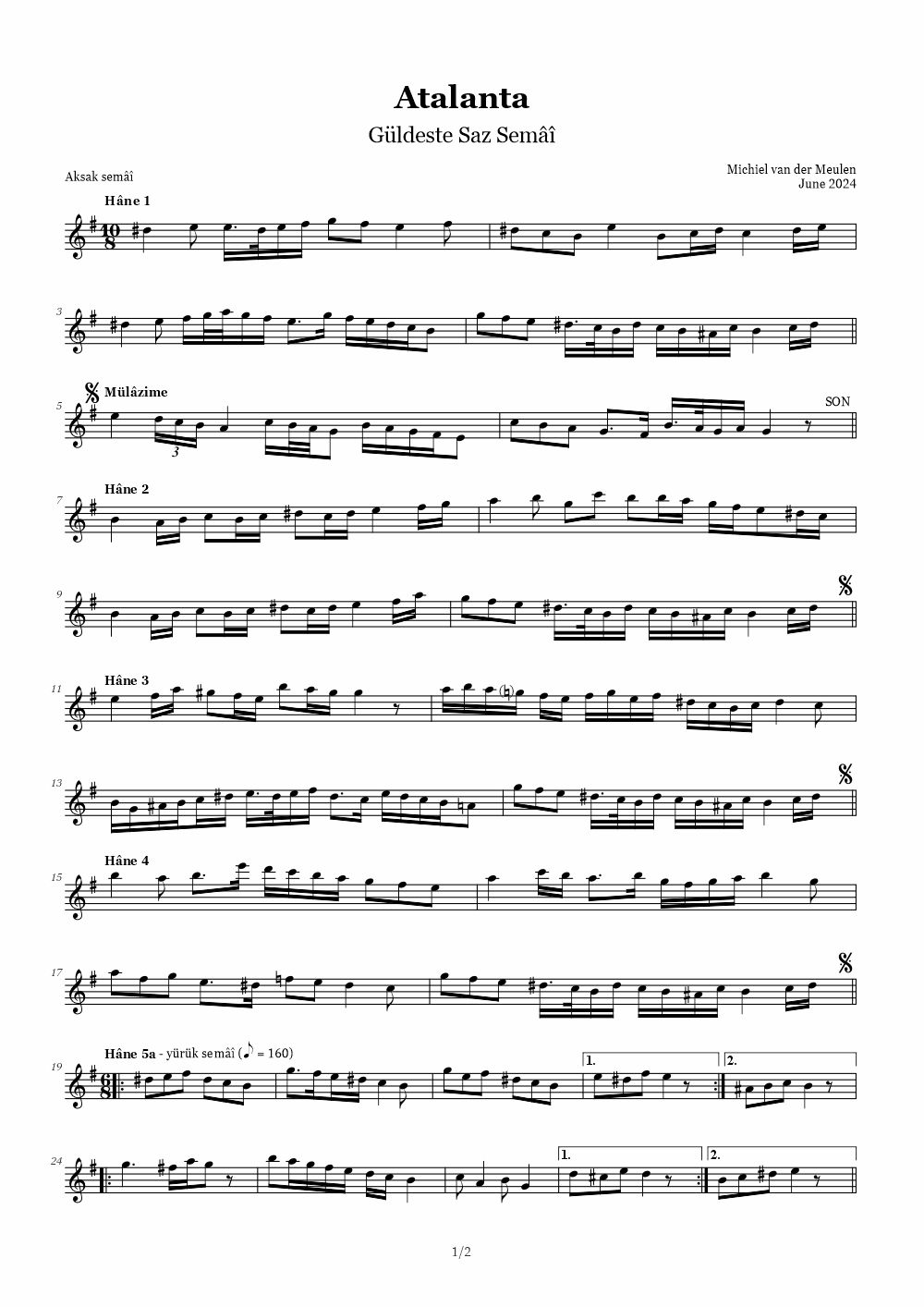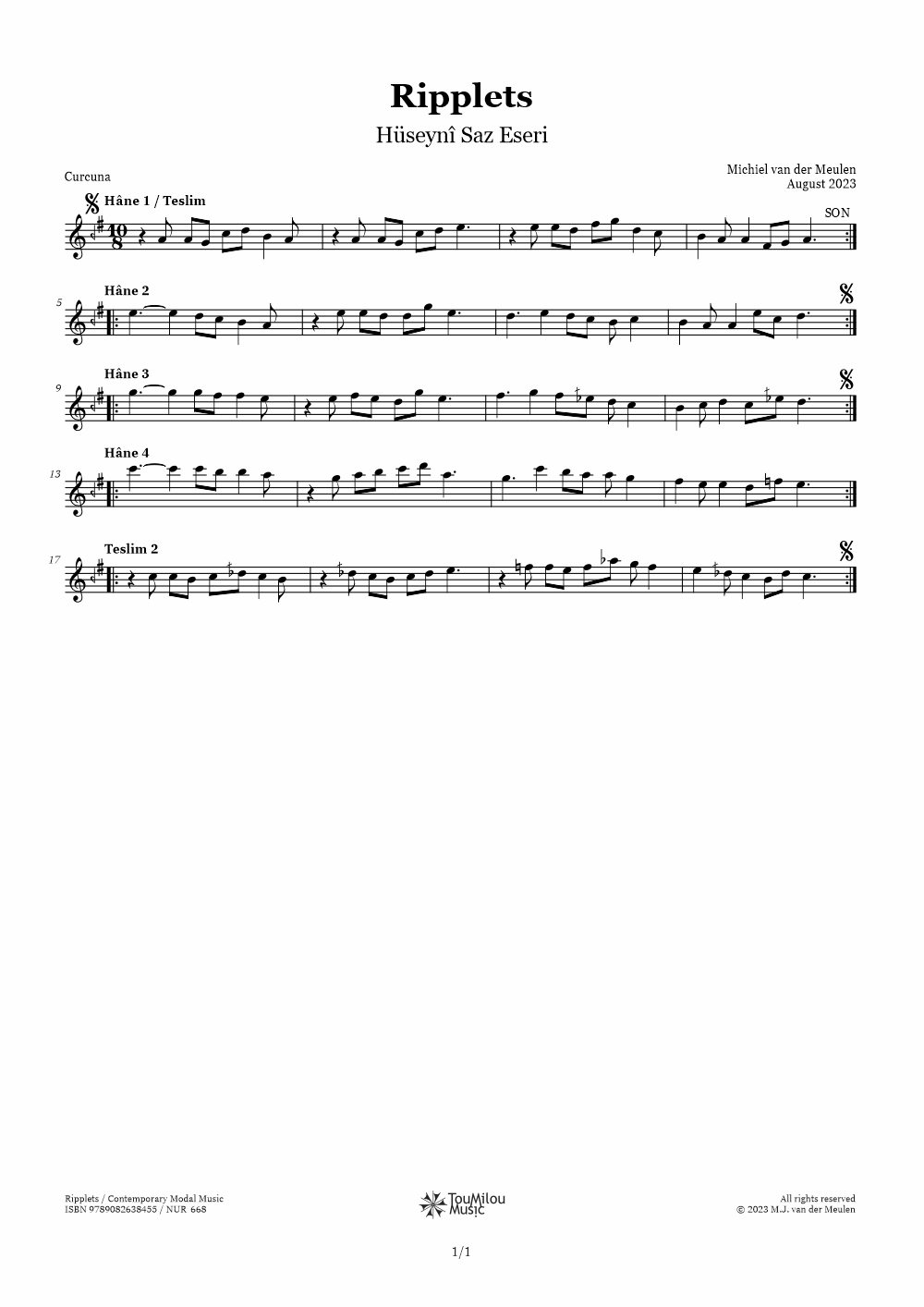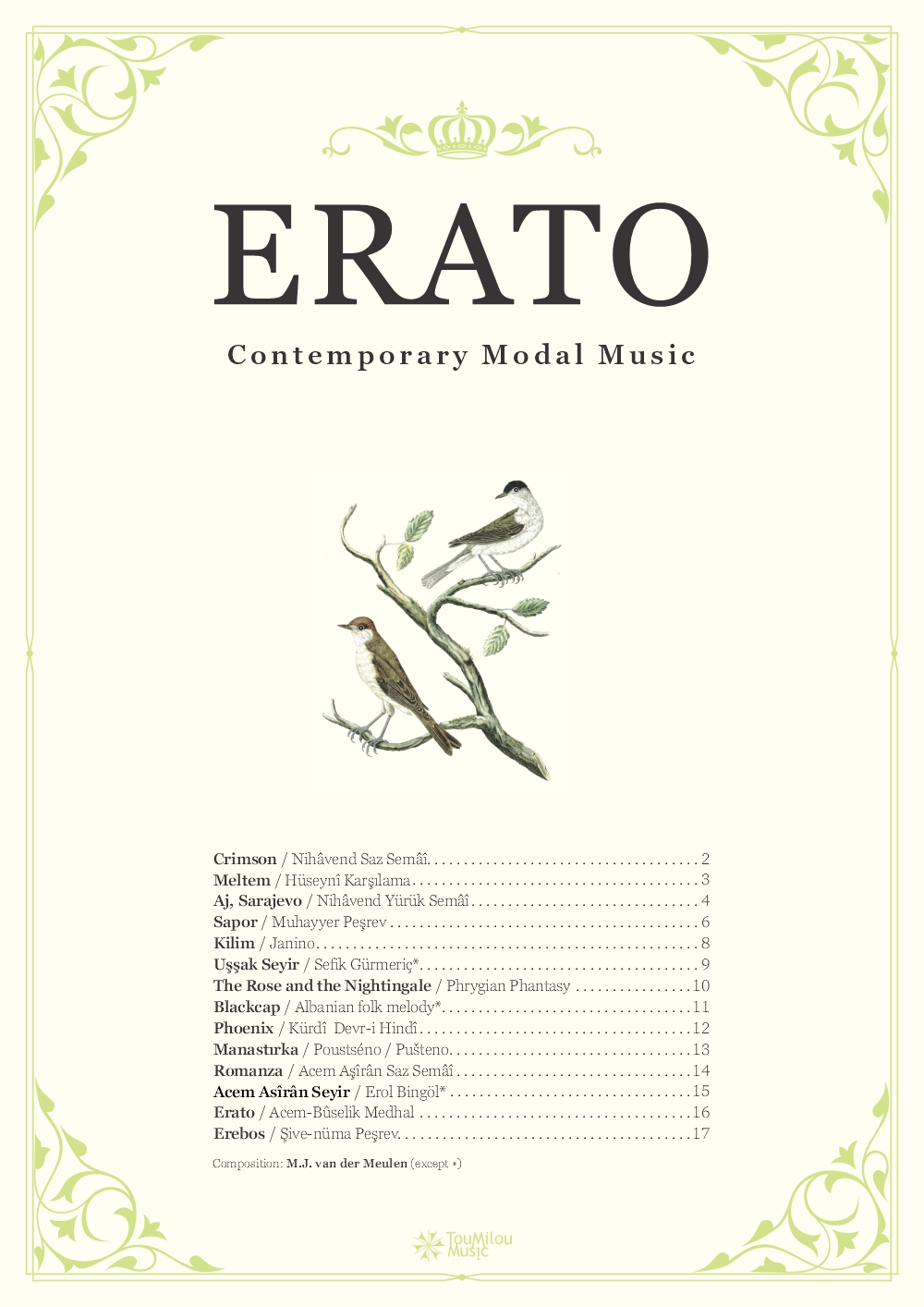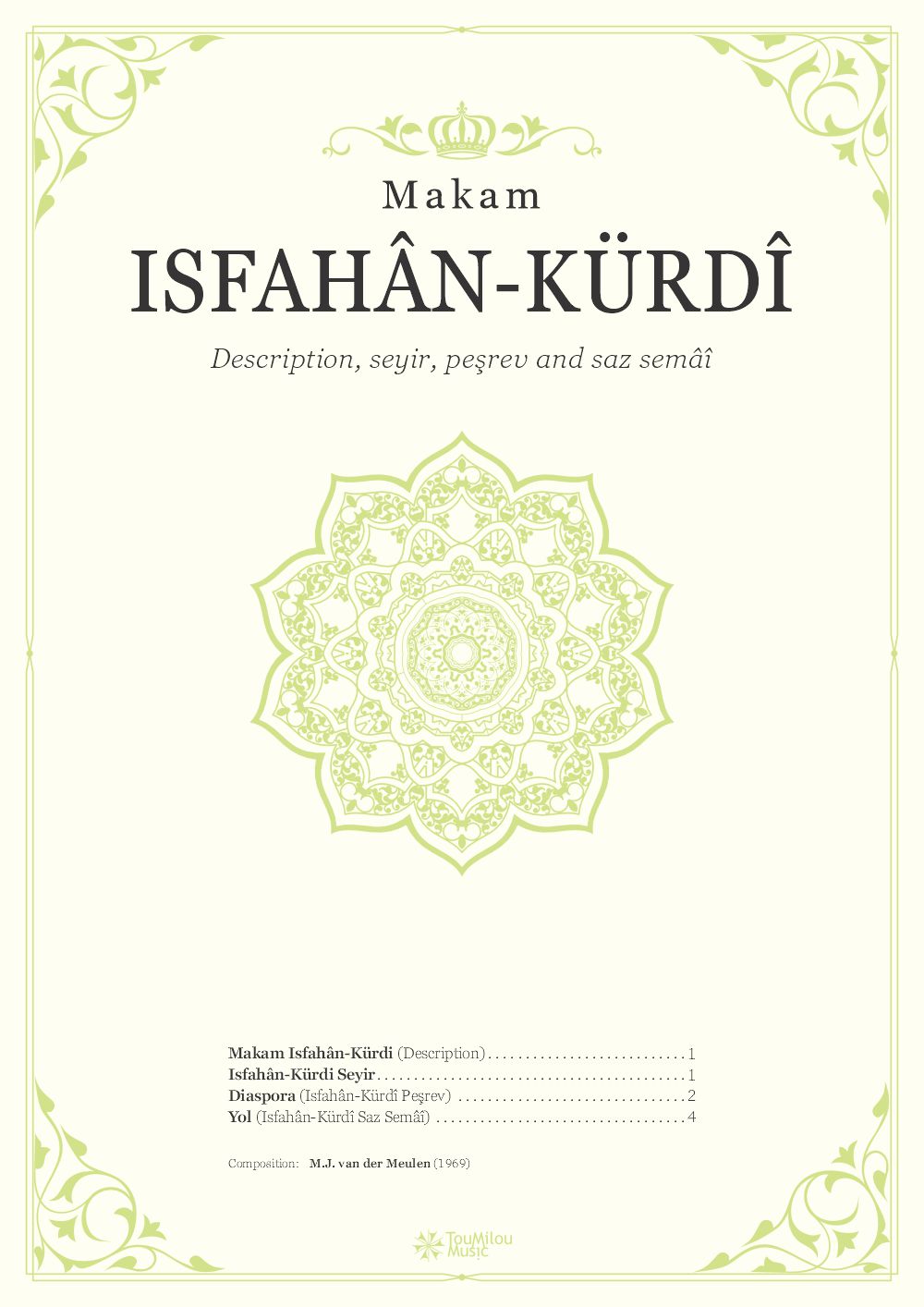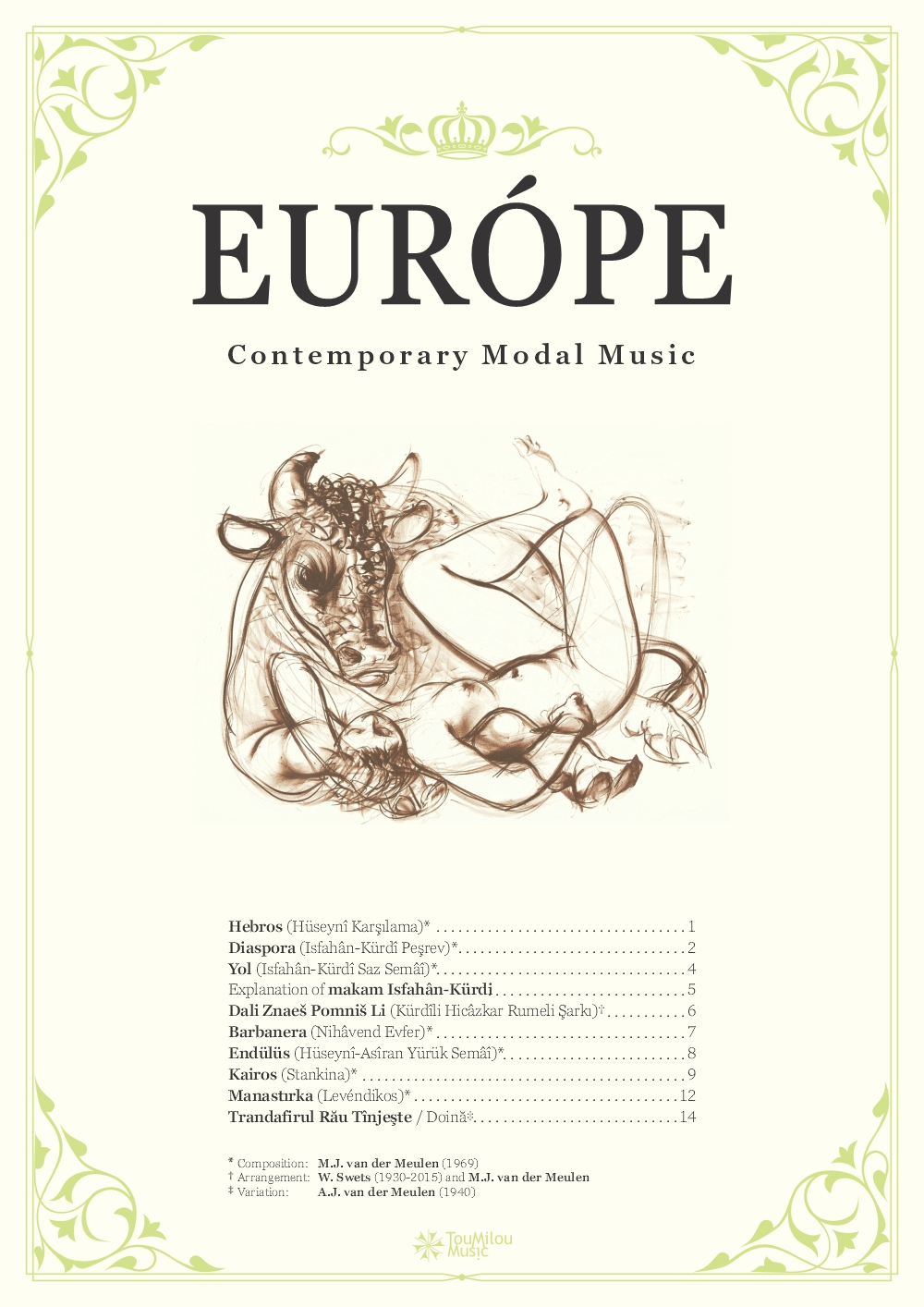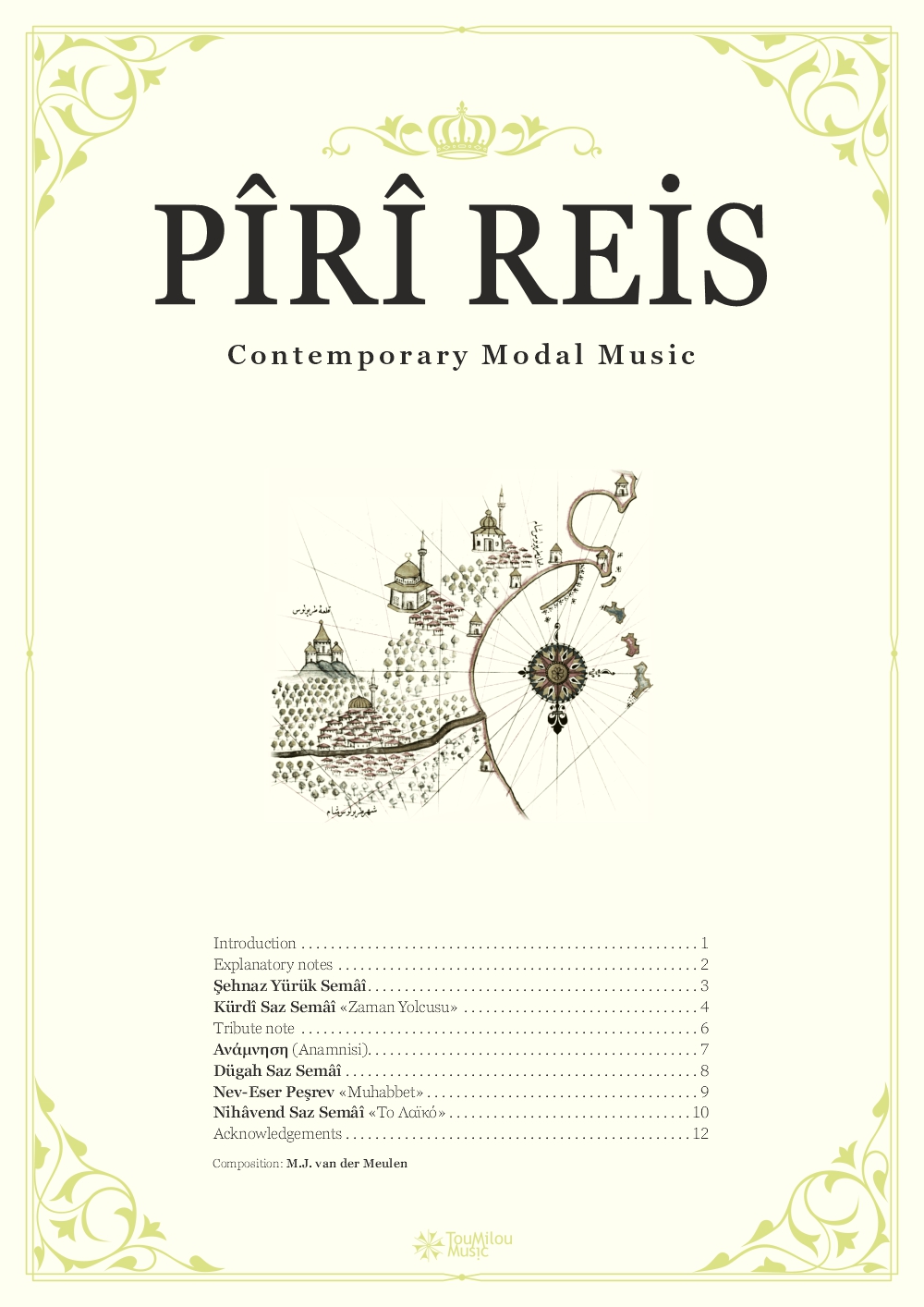Scores
Original compositions / Terms of use in the footer
Published scores
Ariadne / Contemporary modal music / Michiel van der Meulen / TouMilou, 2024 / 11 pp / ISBN 9789083504704
1. Hebros (Hüseynî Karşılama) / 2. Barbanera (Nihâvend Evfer) / 3. Propontis (Phrygian Metal) / 4. Kilim (Janino) / 5. The Rose and the Nightingale (Phrygian Phantasy) / 6. Nazar (Hüseynî mandıra) / 7. Manastırka (Poustséno/Pušteno)
Atalanta / Contemporary modal music / Michiel van der Meulen / TouMilou, 2024 / 2 pp / ISBN 9789082638493
1. Atalanta (Güldeste Saz Semâî)
Ripplets / Contemporary modal music / Michiel van der Meulen / TouMilou, 2023 / 1 p / ISBN 9789082638455
1. Ripplets (Hüseynî Saz Eseri)
Erato / Contemporary modal music / Michiel van der Meulen / TouMilou, 2022 / 17 pp / ISBN 9789082638448
Makam Isfahân-Kürdî / Description, seyir, pesrev and saz semâî / Michiel van der Meulen / TouMilou, 2019 / 4 pp / ISBN 9789082638479
Makam Isfahân-Kürdi (Description) / 1. Isfahân-Kürdi Seyir / 2. Diaspora (Isfahân-Kürdî Peşrev) / 3. Yol (Isfahân-Kürdî Saz Semâî)
Európe / Contemporary modal music / Michiel van der Meulen / TouMilou, 2019 / 14 pp / ISBN 9789082638417
1. Hebros (Hüseynî Karşılama) / 2. Diaspora (Isfahân-Kürdî Peşrev) / 3. Dali Znaeš Pomniš Li (Κürdîli Hicâzkar Rumeli Şarkı) / 4. Barbanera (Nihâvend Evfer) / 5. Endülüs (Hüseynî-Asîran Yürük Semâî) / 6. Kairos (Stankina) / 7. Manastırka (Poustséno/Pušteno) / 8. Yol (Isfahân-Kürdî Saz Semâî) / 9. Trandafirul Rău Tînjeşte (Doină)
Pîrî Reis / Contemporary modal music / Michiel van der Meulen / TouMilou, 2016 / 12 pp / ISBN 9789082638400
1. Şehnaz Yürük Semâî / 2. Kürdî Saz Semâî «Zaman Yolcusu» / 3. Anamnisi / 4. Dügah Saz Semâî / 5. Nev-Eser Peşrev «Muhabbet» / 6. Nihâvend Saz Semâî «To Laiko»
Selected unpublished scores
- Beyâti Saz Semâî (2021)
- Bûselik Saz Semâî (2012)
- Fera-Fezâh Saz Semâî (2018)
- Hicâz Peşrev (2014)
- Hüseynî Saz Semâî (2012)
- Hüseynî-Zemzeme Saz Semâî (2014)
- Kürdîlihicâzkâr Saz Semâî (2014)
- Muhayyer-Kürdi Saz Semâî (2014)
- Rast Saz Semâî (2013)
- Uşşak Saz Semâî (2014)
- Žalajte mi majki (2018) – Arrangement of a Macedonian čalgija song, with newly composed coda section
Explanatory notes
Modal system – Most of Michiel van der Meulen’s compositions are makam-based. A makam is a mode in Turkish/Ottoman art music, but the term may also refer to the modal system as a whole. Each makam has a unique combination of its intervalic structure (cinsler) and melodic progression (seyir), unlike western scales, which are defined by their intervalic structure alone. The most concise description of a makam is obtained by envisaging it somewhere inbetween mere tonal material and a fully-fledged melody.
The number of individual makams is estimated at about 600. Some 120 are formally defined, i.e., categorized and associated with repertoire. Only about 20 of these are widely used today.
Notation system – Makam intonation cannot be captured in standard western notation, which is based on twelve-tone equal-tempered tuning. Michiel van der Meulen mostly uses the Turkish Arel-Ezgi system, which divides a whole tone in 9 commas (komanın). Accidentals are placed at the one (fazla), four (bakkıyye), five (küçük mücennep), eight (büyük mücennep) and nine (tanini) comma intervals (see below figure). Even though this system is more sophisticated than western notation, it can still only approximate makam intonation, which is flexible, depending on melodic progression and tonal centre of gravity.
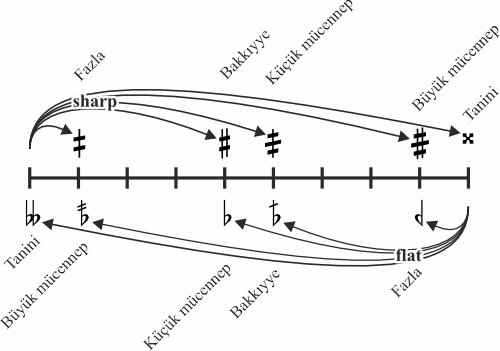
Pitch – Makams are noted at a set key, performers are expected to be able to transpose on the fly. The standard Turkish transposition Bolahenk is one fourth down or one fith up relative to Western concert key (G = D). Other often used transpositions include Kız (G = A), Mansur (G = G) and Süpürde (G = C).
Monophony – There is no harmony in traditional makam music. Western-style second voices and chords are incompatible with the subtlety of a makam’s cinsler, and chord progression rules and aesthetics clash with its seyir. Hence, accompaniment will generally not go beyond a drone or the occasional bass note produced by the lower melody instruments. Musicians play the same melody, contributing with the specific sound and register of their instrument and the ornamentation possibilities it offers. Richness is achieved by heterophony.
Interpretation – Scores of makam music are deliberately not very detailed: performers are expected to be familiar with the characteristic instrument-specific phrasing and embellishments (çeşni).
Further reading
The Turkish Music Makam Guide by Murat Aydemir is a recommended source for further information, which is provided in a very practical way, with scores and audio examples. A large makam sheet music collection can be found on www.neyzen.com.
Modal transcription service
You can contact us if you are in need of a modal transcription of Ottoman/Turkish or Balkan music:
- The microtonal Turkish Arel-Ezgi system will be used.
- Pieces are transcribed in the standard pitch of the makam at hand (regardless of the pitch of the rendition).
- Phrasing and embellishments are captured at the customary level of detail (non-instrument-specific).
- It’ll be melody only – the transciption will not include second voices or chord accompaniments.
- Please familarise yourself with these and other conventions to avoid surprises.
- Make sure you first check the availability of the piece on Yücel Müzik (neyzen.com) and Nota Arşivleri, the two most comprehensive online libraries of Turkish sheet music.
- Short instrumental forms: € 50 (peşrev, saz semâî, yürük semâî, medhal, sirto, longa, oyun havası, suitable Balkan folk melodies).
- Short vocal forms: € 75 (provided that lyrics are available; beste, şarkı, türkü, suitable Balkan folk songs).
- Longer instrumental or vocal forms: request quotation.
- Listen to a rendition by the composer on YouTube.
- View the transcription.
Other material / Terms of use in the footer
Liedboek: Nederlandse volksmuziek op Balkan-wijze toongezet door Wouter Swets / Michiel van der Meulen / TouMilou, 2023 / 33 pp / ISBN 9789082638486
Thirty two arrangements of Dutch folk songs using Balkan rhythms.
Traditionele Turkse Kunstmuziek (Traditional Turkish Art Music) / Digital supplement to the 2nd edition / Wouter Swets / TouMilou, 2019 / 38 pp / ISBN 9789082638424
Nineteen classical Ottoman works by Şevki Bey (1860–1891), Hacı Arif Bey (1831–1885), Selim III (1761–1808), İsak Varon (1884–1962), Dellalzâde İsmâil Efendi (1797–1869), Fehmi Tokay (1889–1959), Refik Fersan (1893–1965), Tanburi Cemil Bey (1871–1916), Zekâi Dede (1825–1879), Wouter Swets (1930–2016), Enfî Hasan Ağa (1670?–1729), Zaharya Efendi (?–1740), Kassamzâde Mehmet Efendi (1705?–1770?), İzzeddin Hümâyî Bey (1876–1950) and Rifat Bey (1820–1888), and thirteen seyirs by Erol Bingöl (1948) and Şefik Gürmeriç (1904–1967).
TouMilou manages balkanika.nl, an online, members-only library of Albanian, Bosnian, Bulgarian, Greek, North Macedonian, Romanian, Serbian and Turkish folk music. Membership is awarded by invitation, to those who can make a significant contribution to the collection.


